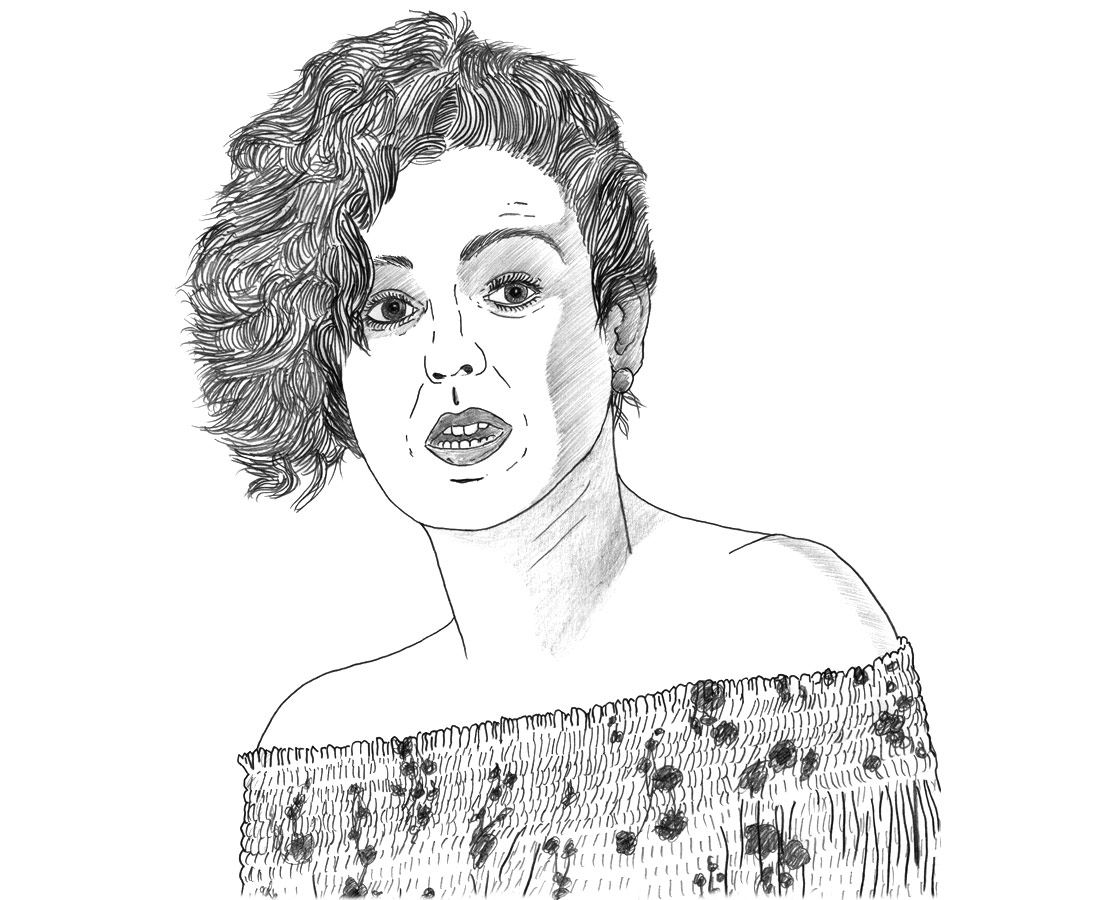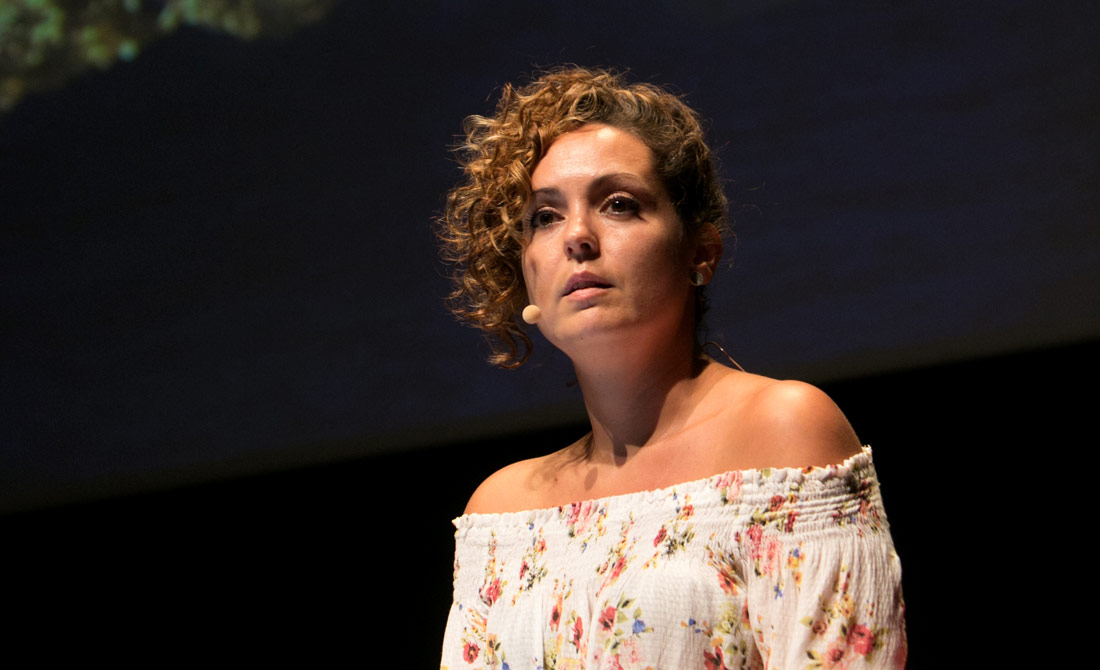
Laura Pando | Illustration by José Antonio Soria | CC-BY
Culture, consuming culture, also leaves a carbon footprint. Laura Panda is well aware of this. For a decade she has been working on calculating that footprint and finding ways to reduce it. She started off doing so as director of sustainability at Festival Republic, and she now is continuing at Julie’s Bicycle, a London not-for-profit organisation that works with cultural institutions to achieve environmental sustainability. At Julie’s Bicycle Pando is in charge, among others, of the Arts Council Environmental Programme, working hand in hand with cultural organisations, such as the National Theatre, to help them to improve their environmental impact.
Here we publish the first of a series of interviews with each of the members of the jury of the second edition of the Cultural Innovation International Prize, organised by the CCCB, and that this time around will have as its central theme, precisely, climate change.
Let’s start off with something that seems evident, or not so evident. Visiting an exhibition at a museum, attending a concert or a theatre play, has an environmental impact…
Of course. Before Julie’s Bicycle, I was environmental manager for a company called Festival Republic, which right now runs some 16 festivals, mainly in the United Kingdom, and also some in Europe. My work consisted precisely of reducing the carbon imprint of those festivals, of which between 60 and 70% was due to the transport that people used to go to and return home from the festival. With museums, that environmental impact is probably less, because in general museums are usually located in urban centres where there are public transport systems; however, they host exhibitions, and these are usually touring exhibitions that are constantly moving from one centre to another.
What other ecological factors must we consider when we consume culture?
Energy. Sound, lighting and video, in general, at concert halls, for example, are big energy consumers. And if you take a concert to a bull ring or a park, you also need to take generators, which you have to transport and then return to their place of origin. And normally, those generators consume diesel oil, a highly contaminant fuel. What’s more, what often happens, also at concert halls, is that they have alternative generators that are constantly functioning in case the electricity cuts out. The ecological footprint is extremely great.
It’s the same for cultural centres like the CCCB. You have to provide lighting for the exhibitions, obviously. And then the materials that you use. If you are going to reuse them in the future, the carbon footprint is reduced. If, in contrast, you are going to use them at only one exhibition and then throw them away, the footprint is monumental.
They can be recycled…
We usually think that with recycling the materials that we employ we have done enough, but that action is also part of the problem. And it is not only a case of information leaflets. It is also important to take into account what is sold at a restaurant at the centre or museum, for example, whether the cups are made of disposable paper or plastic, or whether, to the contrary, reusable utensils are used. Even the food offered influences the amount of waste generated by the packing of that food; how different types of waste are separated. Or water consumption, for example, which is key. There are many WC cisterns that use an absurd amount of water every time they are flushed. We are talking about things that don’t seem to be very interesting or very much related to art, but we all go to the bathroom several times a day. And there are many ways of influencing and reducing those impacts.
At Julie’s Bicycle you advise cultural enterprises in order, precisely, to help them reduce their environmental impact.
At the outset, that was never our intention. We began by offering the cultural sector a tool, the carbon footprint calculator, which has different versions that adapt to different scenarios, such as festivals, theatres and museums, to offer very specific results on the nature of each activity. It is a free tool, available through us. And it was based on offering that tool that we started up the consulting service. We found that the different users of the tool were saying to us: “We want to do more. Yes, we are measuring our impacts, we know our carbon footprint, we are reducing them because we have done A, B and C. But now what?”
Who comes to see you?
Right now we are working with an institution called Somerset House, which is one of the main cultural institutions not only in London but the whole of England. We are also working with the National Theatre, with the Royal Albert Hall, with many very important institutions.
Why do they want to reduce their carbon footprint?
There’s no single answer. I suppose that to start, for ethical, personal and professional reasons, above all in the case of organisations that are largely fuelled by public funding, which brings with it a social responsibility. Also for their reputation, because doing nothing is increasingly risky; at least right now in England and the United Kingdom, that’s the way it is: people have a poor view of those who do nothing. And that reputation influences where you have your pension funds, which bank you work with or who your sponsors are. In this sense, the cultural sector has come together to collaborate and this has been the driving force that has led to this change.
How?
They have a clear understanding that this is not an issue of competing for audiences, but rather that joining forces to reduce the environmental impact that they have is something that benefits everyone. Furthermore, opportunities for sponsorship are created.
In what sense?
Traditional sponsorship was “I have this enterprise and I want, with your good name, to improve my own. I give you money and you put my name down and everything is hunky-dory for all of us”. This is becoming history, because there are sponsorship options where the value is greater. “You give me the money and I put you in this collaboration group and I introduce you to these people and we create and programme events together. Or I even present you to my audiences. If I have complete faith in this energy being 100% renewable, you reduce the price of the bill for me and I ensure that I introduce you to all my potential clients”. There is no obligation, it’s a kind of advertising based on both parties coinciding in certain values and in a certain direction of vision.

Laura Pando | © CCCB, 2017. Author: Miquel Taverna
Does the environmental awareness of institutions and companies get through to users?
I believe and I trust that it does. A good example is the Shambala Festival, which has become like the ethos of ethics. It started almost as a party among friends, gradually grew and now moves some 10,000 people. At one point, the organisers started to consider the ecological impact of the festival and took very risky but extremely interesting measures. To start, they use 100% renewable energy, they have absolutely no carbon footprint in electricity terms and that is very impressive, and very difficult to achieve with a festival that takes place outside an urban environment.
During the festival, they have eliminated all plastics, they do not sell bottles of water, but a bottle that can be refilled at any of the many taps distributed around the venue.
But that means they lose business.
There are companies that take the risk and say: “I’m going to earn a little bit less here but I think that what I am doing socially has a value that goes far beyond what I would have pocketed for having sold those bottles of water”. They do the calculation and it is not only an economic calculation, it is one that also takes into account the social repercussions. Last year they did something really interesting. Shall I explain?
Go ahead.
The got rid of all the old food stands that sold meat and fish. And people went mad. On the Internet, on the social media networks, people got very angry. They were touching something very personal, which is diet, food, something that people consider as freedom of choice, being able to choose what they eat and what they don’t eat.
Not everyone is vegan.
That action generated intense and extremely interesting debate. The festival programme talked about how meat is produced, what farms are really like, how they treat the animals. Also, they were extremely careful selecting who came to do the food, so that people would enjoy the culinary experience. The success was incredible: 40% of those attending emerged saying that they were going to reconsider their diet.
But are these types of debates the responsibility of cultural organisations not working in this area?
There is a report that exists called “Perceptions matter” that was produced in the United Kingdom. The results show that the cultural sector is the only sector where the majority of people think that they have a moral obligation to portray and represent values in favour of social causes. This clearly indicates that there is a social expectation with respect to these types of institutions: they are expected to reflect to some extent those values that are more human and that make us feel a little bit better about ourselves. Cultural institutions have to provide a safe place where conversations as difficult as the one on climate change can be held.
What does a safe place mean?
It means that you present it in a way that is not polarised and you allow people to express themselves freely, without fear of being judged; where people can understand each other; where you can be vegan and I can be a super-carnivore and we can have a conversation and you don’t judge me and I don’t judge you either, because it is moderated in a space that may be a play, for example, that deals with meat production. And you and I leave the theatre and we have just seen a play that has left our mind full of ideas, and we comment on it, while I eat my fillet and you eat your bit of lettuce. And we take that conversation home with us, and from home you take it to work.
Generally people don’t like to be lectured. Do plays on climate change function to stir consciences and provoke that conversation?
Environmental works that have had a very major impact have not even mentioned climate change nor have they said to me what I have to do or what I don’t have to do. But yes, they have struck a chord with me. That is the beauty of art and culture, and their true power, that nothing is formalised and standardised, so they can spoon-feed you. No way. It has no political interests, but rather a voracious hunger for inventing a better future for humankind.






Leave a comment